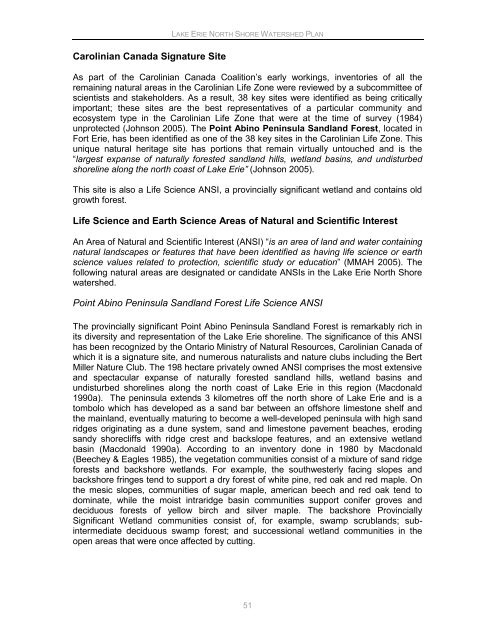Lake Erie North Shore Watershed Plan - Niagara Peninsula ...
Lake Erie North Shore Watershed Plan - Niagara Peninsula ...
Lake Erie North Shore Watershed Plan - Niagara Peninsula ...
You also want an ePaper? Increase the reach of your titles
YUMPU automatically turns print PDFs into web optimized ePapers that Google loves.
LAKE ERIE NORTH SHORE WATERSHED PLAN<br />
Carolinian Canada Signature Site<br />
As part of the Carolinian Canada Coalition‟s early workings, inventories of all the<br />
remaining natural areas in the Carolinian Life Zone were reviewed by a subcommittee of<br />
scientists and stakeholders. As a result, 38 key sites were identified as being critically<br />
important; these sites are the best representatives of a particular community and<br />
ecosystem type in the Carolinian Life Zone that were at the time of survey (1984)<br />
unprotected (Johnson 2005). The Point Abino <strong>Peninsula</strong> Sandland Forest, located in<br />
Fort <strong>Erie</strong>, has been identified as one of the 38 key sites in the Carolinian Life Zone. This<br />
unique natural heritage site has portions that remain virtually untouched and is the<br />
“largest expanse of naturally forested sandland hills, wetland basins, and undisturbed<br />
shoreline along the north coast of <strong>Lake</strong> <strong>Erie</strong>” (Johnson 2005).<br />
This site is also a Life Science ANSI, a provincially significant wetland and contains old<br />
growth forest.<br />
Life Science and Earth Science Areas of Natural and Scientific Interest<br />
An Area of Natural and Scientific Interest (ANSI) “is an area of land and water containing<br />
natural landscapes or features that have been identified as having life science or earth<br />
science values related to protection, scientific study or education” (MMAH 2005). The<br />
following natural areas are designated or candidate ANSIs in the <strong>Lake</strong> <strong>Erie</strong> <strong>North</strong> <strong>Shore</strong><br />
watershed.<br />
Point Abino <strong>Peninsula</strong> Sandland Forest Life Science ANSI<br />
The provincially significant Point Abino <strong>Peninsula</strong> Sandland Forest is remarkably rich in<br />
its diversity and representation of the <strong>Lake</strong> <strong>Erie</strong> shoreline. The significance of this ANSI<br />
has been recognized by the Ontario Ministry of Natural Resources, Carolinian Canada of<br />
which it is a signature site, and numerous naturalists and nature clubs including the Bert<br />
Miller Nature Club. The 198 hectare privately owned ANSI comprises the most extensive<br />
and spectacular expanse of naturally forested sandland hills, wetland basins and<br />
undisturbed shorelines along the north coast of <strong>Lake</strong> <strong>Erie</strong> in this region (Macdonald<br />
1990a). The peninsula extends 3 kilometres off the north shore of <strong>Lake</strong> <strong>Erie</strong> and is a<br />
tombolo which has developed as a sand bar between an offshore limestone shelf and<br />
the mainland, eventually maturing to become a well-developed peninsula with high sand<br />
ridges originating as a dune system, sand and limestone pavement beaches, eroding<br />
sandy shorecliffs with ridge crest and backslope features, and an extensive wetland<br />
basin (Macdonald 1990a). According to an inventory done in 1980 by Macdonald<br />
(Beechey & Eagles 1985), the vegetation communities consist of a mixture of sand ridge<br />
forests and backshore wetlands. For example, the southwesterly facing slopes and<br />
backshore fringes tend to support a dry forest of white pine, red oak and red maple. On<br />
the mesic slopes, communities of sugar maple, american beech and red oak tend to<br />
dominate, while the moist intraridge basin communities support conifer groves and<br />
deciduous forests of yellow birch and silver maple. The backshore Provincially<br />
Significant Wetland communities consist of, for example, swamp scrublands; subintermediate<br />
deciduous swamp forest; and successional wetland communities in the<br />
open areas that were once affected by cutting.<br />
51
















